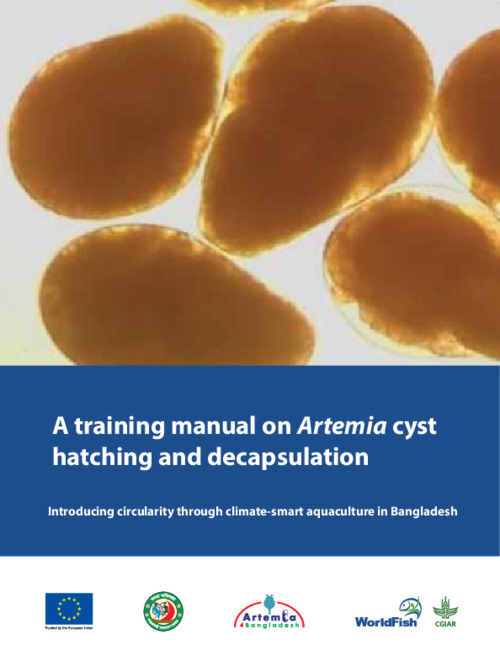Please use this identifier to cite or link to this item:
https://hdl.handle.net/20.500.12348/5375
A Training Manual on Artemia Cyst Hatching and Decapsulation
| dc.creator | Rahman, M.M. | en_US |
| dc.creator | Sorgeloos, P. | en_US |
| dc.date.accessioned | 2023-01-15T15:36:58Z | |
| dc.date.available | 2023-01-15T15:36:58Z | |
| dc.date.issued | 2022 | en_US |
| dc.identifier.citation | Muhammad Rahman, Patrick Sorgeloos. (10/12/2022). A Training Manual on Artemia Cyst Hatching and Decapsulation. Bayan Lepas, Malaysia: WorldFish (WF). | en_US |
| dc.identifier.isbn | 9789843535795 | en_US |
| dc.identifier.uri | https://hdl.handle.net/20.500.12348/5375 | |
| dc.description.abstract | Artemia nauplii is an excellent live food source to fulfill the nutritional requirement in larviculture of crustaceans and marine fish due to its high digestible protein content, essential fatty acid and small in size (approximately 450 µm) (Sorgeloos et al., 1998, 2001). Artemia is mainly marketed worldwide as encapsulated cysts which allow it for long term storage, maintain the quality and are ready to hatch whenever necessary. Globally, annual Artemia cyst consumption increased from less than 100 metric tonnes (MT) in the 1980s to over 3,000 MT in recent years harvested mainly from natural salt lakes. This tremendous increase in demand followed by price hike of Artemia cyst in the international market caused limited application in quantity during larviculture in crustacean and marine fish hatcheries. In many countries, hatchery workers lack the sufficient knowledge and skill in standardization of the application of Artemia nauplii during larval rearing. This resulted in increased cost, disease incidence, reduced survival in larval rearing. Several countries including Thailand, Vietnam are successful in commercial Artemia biomass production in the coastal salt farms (Anh et al., 1997, Montakin personal communication) to promote socio economics of thousands of salt farmers. In recent years, Vietnamese aquaculture activities are expanding with new aquaculture species such as mud crab, mud skipper, marine snails with the support of locally produced Artemia cyst and biomass (Hoa and Hong, 2019). In Bangladesh, about hundred shrimp (Penaeus monodon) and prawn (Macrobra chiumrosenbergii) hatcheries produce more than 10 billion post larvae per year (DoF, 2019) with annual consumption of approximately 40 MT imported Artemia cyst. The objectives of the training manual on Artemia hatching and decapsulation are to enhance knowledge and skill of the aquaculture professionals to optimize the use of Artemia nauplii in the larval rearing. In addition, the standardized hatching procedure will be used to inoculate Artemia nauplii for the culture in the salt farms in Bangladesh | en_US |
| dc.format | en_US | |
| dc.language | en | en_US |
| dc.publisher | WorldFish (WF) | en_US |
| dc.rights | Copyrighted; all rights reserved | en_US |
| dc.subject | no poverty | en_US |
| dc.subject | zero hunger | en_US |
| dc.subject | climate adaptation and mitigation | en_US |
| dc.subject | poverty reduction, livelihoods and jobs | en_US |
| dc.subject | cyst capsulation | en_US |
| dc.title | A Training Manual on Artemia Cyst Hatching and Decapsulation | en_US |
| dc.type | Manual | en_US |
| cg.contributor.crp | Fish | en_US |
| cg.contributor.funder | European Union | en_US |
| cg.contributor.project | Introducing Circularity Through Climate-Smart Aquaculture in Bangladesh (Artemia4Bangladesh) | en_US |
| cg.coverage.country | Bangladesh | en_US |
| cg.coverage.region | Southern Asia | en_US |
| cg.subject.agrovoc | artemia | en_US |
| cg.subject.agrovoc | hatching | en_US |
| cg.subject.agrovoc | Fish | en_US |
| cg.contributor.affiliation | WorldFish | en_US |
| cg.contributor.affiliation | Ghent University | en_US |
| cg.contributor.affiliation | Bangladesh Ministry of Fisheries And Livestock | en_US |
| cg.identifier.status | Open access | en_US |
| cg.contribution.worldfishauthor | Rahman, M.M. | en_US |
| cg.description.theme | Sustainable aquaculture | en_US |
| cg.creator.id | Muhammad Meezanur Rahman: 0000-0002-7305-8292 | en_US |
Files in this item
This item appears in the following Collection(s)
-
Sustainable aquaculture [2735]
